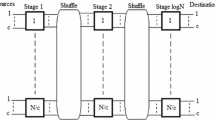Abstract
High-performance supercomputers generally comprise millions of CPUs in which interconnection networks play an important role to achieve high performance. New design paradigms of dynamic on-chip interconnection network involve a) topology b) synthesis, modeling and evaluation c) quality of service, fault tolerance and reliability d) routing procedures. To construct a dynamic highly fault tolerant interconnection networks requires more disjoint paths from each source-destination node pair at each stage and dynamic rerouting capability to use the various available paths effectively. Fast routing and rerouting strategy is needed to provide reliable performance on switch/link failures. This paper proposes two new architecture designs of fault tolerant interconnection networks named as reliable interconnection networks (RIN-1 and RIN-2). The proposed layouts are multipath multi-stage interconnection networks providing four disjoint paths for all the source-destination node pairs with dynamic rerouting capability. The designs can withstand switch failures in all the stages (including input and output stages) and provide more reliability. Reliability analysis of various MIN architectures is evaluated. On comparing the results with some existing MINs it is evident that the proposed designs provides higher reliability values and fault tolerance.




Similar content being viewed by others
References
Jiang X, Pattavina A, Horiguchi S (2008) Strictly nonblocking f-cast photonic networks. IEEE/ACM Trans Networking (TON) 16(3):732–745
Yang Y, Wang J (2005) Routing permutations on baseline networks with node-disjoint paths. IEEE Trans Parallel Distrib Syst 16(8):737–746
Gunawan I (2008) Reliability analysis of shuffle-exchange network systems. Reliab Eng Syst Saf 93(2):271–276
Shen X, Yang F, Pan Y (2001) Equivalent permutation capabilities between time-division optical omega networks and non-optical extra-stage omega networks. IEEE/ACM Trans Networking (TON) 9(4):518–524
Arzilawati Md Yunus N, Othman M (2014) Reliability evaluation and routing integration in shuffle exchange omega network. J Netw 9(7):1732–1737
Bistouni F, Jahanshahi M (2015) Improving the reliability of the Benes network for use in large-scale systems. Microelectron Reliab 55(3):679–695
Veglis A, Pomportsis A (2001) Dependability evaluation of interconnection networks. Comput Electr Eng 27(3):239–263
He R, Delgado-Frias JG (2007) Fault tolerant interleaved switching fabrics for scalable high-performance routers. IEEE Trans Parallel Distrib Syst 18(12):1727–1739
Nieminen E (2014) A contention-free parallel access by butterfly networks for turbo interleavers. IEEE Trans Inf Theory 60(1):237–251
Pham P-H, Song J, Park J, Kim C (2013) Design and implementation of an on-chip permutation network for multiprocessor system-on-chip. IEEE Trans Very Large Scale Integr (VLSI) Syst 21(1):173–177
Chiuyuan C, Jing-Kai L (2006) An efficient tag-based routing algorithm for the backward network of a bidirectional general shuffle-exchange network. IEEE Commun Lett 10(4):296–298
Sengupta J, Bansal P (2004) Performance analysis of static and dynamic fault-tolerant irregular networks. Proceedings of IEEE Region 10 International Conference on Electrical and Electronic Technology. pp 5–8
Chen CW, Lu NP, Chung CP (2003) 3-Disjoint gamma interconnection networks. J Syst Softw 66(2):129–134
Chen CW, Chung CP (2005) Designing a disjoint paths interconnection network with fault tolerance and collision solving. J Supercomput 34(1):63–80
Bistouni F, Jahanshahi M (2015) Pars network: a multistage interconnection network with fault-tolerance capability. J Parallel Distrib Comput 75:168–183
Danilewicz G, Rajewski R (2014) The architecture and strict-sense non-blocking conditions of a new baseline-based optical switching network composed of symmetrical and asymmetrical switching elements. IEEE Trans Commun 62(3):1058–1069
Raponi PG, Andriolli N, Cerutti I, Torres D, Liboiron-Ladouceur O, Castoldi P (2013) Heterogeneous optical space switches for scalable and energy-efficient data centers. J Lightwave Technol 31(11):1713–1719
Chen Z (2013) A Class of Incomplete Gamma Interconnection Network, [Report] China: Tsinghua University, pp 1–12
Rajkumar S, Goyal NK (2014) Design of 4-disjoint gamma interconnection network layouts and reliability analysis of gamma interconnection Networks. J Supercomput 69(1):468–491
Bistouni F, Jahanshahi M (2015) Scalable crossbar network: a non-blocking interconnection network for large-scale systems. J Supercomput 71:697–728
Fan CC, Bruck J (2000) Tolerating multiple faults in multistage interconnection networks with minimal extra stages. IEEE Trans Comput 49(9):998–1004
Balpande SS, Lande SB, Rungta S (2008) Behavioral modeling, simulation and synthesis of an output queuing Batcher-Banyan ATM switch with internal speedup network. 16th IEEE International Conference on Networks pp 1–4
Bistouni F, Jahanshahi M (2014) Analyzing the reliability of shuffle-exchange networks using reliability block diagrams. Reliab Eng Syst Saf 132:97–106
Bansal P, Singh K, Joshi RC (1992) Quad tree: a cost-effective fault-tolerant multistage interconnection network. IEEE Proc Eleventh Annu Joint Conf IEEE Comput Commun Soc 2:860–866
Cheng L, Venkatesan R, Heys HM (2006) Architecture and Performance Analysis of the Multicast Balanced Gamma Switch for Broadband Communications. Proceedings of IEEE International Conference on Computer Systems and Applications, pp 381–388
Lee KY, Hegazy W (1998) The extra stage gamma network. IEEE Trans Comput 37(11):1445
Chen CW, Lu NP, Chen TF, Chung C-P (2000) Fault-tolerant gamma interconnection networks by chaining. IEE Proc-Comput Digit Tech 147(2):75–81
Chaturvedi SK, Misra KB (2002) An efficient multi-variable inversion algorithm for reliability evaluation of complex systems using path sets. Int J Reliab Qual Saf Eng 9(3):237–259
Goyal NK, Misra RB, Chaturvedi SK (2005) SNEM: a new approach to evaluate terminal pair reliability of communication networks. J Qual Maint Eng 11(3):239–253
Goyal NK (2010) Network reliability evaluation with changes in layout. Int J Performabil Eng 6(1):63–76
Goyal NK, Misra KB (2008) Optimum link capacity allocation in a communication network. IE (I) J-ET 88:18–21
Acknowledgments
The authors would like to thank the editor and anonymous reviewers whose helpful comments improved the quality of this paper. The author would also like to thank Professors of Reliability Engineering Centre, IIT Kharagpur for their support and suggestions.
Conflict of interest
The authors declare that they have no conflict of interest.
Author information
Authors and Affiliations
Corresponding author
Rights and permissions
About this article
Cite this article
Rajkumar, S., Goyal, N.K. Reliable multistage interconnection network design. Peer-to-Peer Netw. Appl. 9, 979–990 (2016). https://doi.org/10.1007/s12083-015-0368-5
Received:
Accepted:
Published:
Issue Date:
DOI: https://doi.org/10.1007/s12083-015-0368-5




